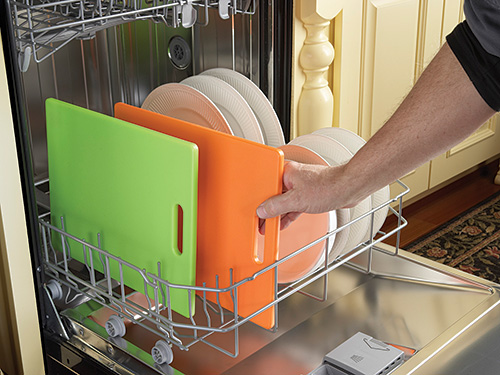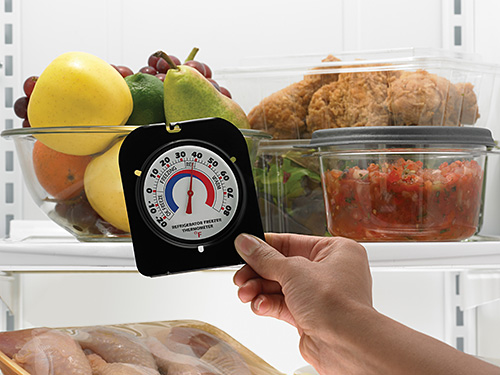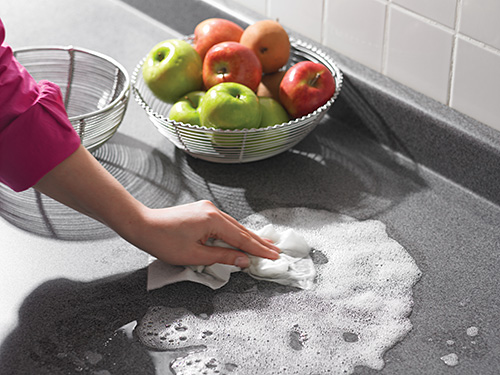
Food mishandling in home kitchens causes a significant amount of foodborne disease (food poisoning). Numerous food safety problems commonly occur in home kitchens--fortunately, many of these problems can be corrected easily and inexpensively. The Home Kitchen Check-Up can help you identify how to reduce the risk for foodborne disease in your home kitchen.
Part A
How clean is your kitchen? What grade would a food inspector give it? To find out, take a few minutes to complete this check-up. Count one (1) for each question if all of the bulleted points are TRUE for your kitchen.
Kitchen Facilities
- Countertops and Cutting Boards:
- Countertops and cutting boards have a smooth, corrosion-resistant, non-absorbent, and easily cleanable surface.
- Countertops and cutting boards do NOT have pits, chips, scratches, deep grooves, distortion, or stains.
- Countertops and cutting boards s are clean to sight and touch.
- Countertops and cutting boards are always sanitized before and after food preparation.
- Food Preparation Equipment:
- Equipment is clean to sight and touch.
- Microwave oven seals and inside cooking space are free of debris (e.g., stains, crumbs, old food, dust).
- Can opener is clean and free of debris.
- Cleaning Equipment & Materials:
- Hot water works.
- Kitchen sponges/brushes/dishrags look fresh, clean, and visibly free of debris.
- Paper towels are available.
- Automatic dishwasher is available and functions.
- Soap and/or sanitizer is available near kitchen sink.
- Hands are dried only with paper towels or designated dishtowel that is NOT used for other purposes.
- Overall Cleanliness:
- Garbage is covered, or if exposed, is in an area at least a few feet from food preparation areas and is NOT overflowing from the container.
- Pets are never in kitchen area or on food preparation surfaces (e.g., counters).
- There is NO evidence of rodents (e.g., droppings) or insects (e.g., brown spots on or near baseboards).
Perishable Foods (e.g., dairy, eggs, meat, poultry, fish, and take out foods)
- Transporting Perishable Foods:
- Cold perishable foods are transported quickly from the grocery store and, once home, are immediately refrigerated or frozen.
- Take-out and hot foods are transported quickly from the grocery store or restaurant and, once home, are immediately eaten, refrigerated, or frozen.
- Preparing Perishable Foods:
- Frozen meat, fish, and poultry are thawed in the refrigerator, microwave oven, or in cold water.
- Frozen meat, fish, and poultry are totally thawed before they are cooked.
- A food thermometer is used to be sure raw ground meat, chicken, and leftovers are heated to at least 165°F.
- Only pasteurized eggs are used in recipes calling for eggs that are not cooked until the yolk is solid.
- Immediately after cooking, large containers of hot food (e.g., soup, stews) are served or placed in shallow containers and cooled in the refrigerator or freezer.
- Holding Perishable Foods:
- Perishable foods, including those in picnic and packed lunches, are never left at danger zone temperatures (41°F to 135°F) more than 2 hours.
- Perishable foods are discarded if left at danger zone temperatures (41°F to 135°F) more than 2 hours.
- Refrigerated Foods:
- Refrigerated foods are spaced to allow air to circulate freely.
- Eggs are stored in their original carton.
- Raw meat/fish/poultry is stored in sealed, non-leaking containers placed below produce and other ready-to-eat food.
- NO refrigerated food is past its expiration date.
- Leftover foods are labeled with date of preparation (or date purchased).
- Leftover foods are eaten or discarded within 7 days.
- Refrigerator:
- has a working thermometer.
- has a temperature between 32 to 40°F.
- is cleaned and sanitized regularly.
- Freezer:
- has a working thermometer.
- has a temperature less than or equal to 0°F.
Storage
- Dry Foods (e.g., packaged and canned foods):
- appear to be wholesome and safe to eat.
- are in tightly closed packages (packages are NOT torn or damaged; canned foods do NOT have dents in a seam or edge, deep dents in any part of the can, or bulging lids).
- are stored in clean, cool, dry locations and NOT stored under a sink or near drains/pipes.
- are stored at least 6-inches above floor.
- are rotated on a first-in, first-out basis (i.e., one box is used up before another is opened).
- Poisonous Substances (e.g., household cleaners, sanitizers, and other household chemicals):
- are stored away from foods to prevent contamination of food and food preparation equipment or utensils.
- are in their original containers; containers are intact and clearly labeled.
- when used, insect/rodent-bait stations are covered and tamper resistant.
Personal Hygiene
- Handwashing:
- You always wash your hands with soap & water
- BEFORE preparing food or eating.
- AFTER handling raw meat/poultry/fish or raw produce.
- AFTER smoking, eating, or drinking.
- Food Preparation:
- You minimize touching foods with your bare hands and avoid preparing food when you are sick (i.e., have diarrhea, fever, vomiting, open sores, or persistent cough/sneezing/runny nose).
- Raw produce is washed thoroughly. Melons are washed before being sliced.
Part A Scoring
So, just how food safe is your home kitchen?
Count the number of questions where all of the bulleted items are TRUE for your kitchen in Part A, and then check your grade! If you got anything less than an A, look over the items you did not check and make changes to get your whole kitchen as food safe as it can be!
| Score | Grade | Evaluation |
|---|---|---|
| 0-3 | F | FRIGHTENING! Don’t make another meal until you do some serious cleaning and improvement of your behaviors! The many food safety violations in your kitchen are hazardous to your health. Review the items you did not check and immediately make changes. |
| 4-6 | D | DANGER! Your kitchen and food habits pose many food safety dangers. Review the items you did not check and make changes right away! |
| 7-9 | C | CAUTION! Some parts of your kitchen and your behaviors are food safe, but not all. Review the items you did not check and make changes to get your whole kitchen and self in top food safety shape. |
| 10-13 | B | BETTER! Overall, your kitchen and habits are in good shape; but there are areas where you can improve. Take steps to get your whole kitchen and self in awesome food safety shape. |
| 14 | A | AWESOME! KEEP UP THE GOOD WORK! |
Part B
What do you know about safe food?
Select a. or b. to answer these questions and find out!
- To make ground meat, chicken, and leftover food safe to eat, cook until its
internal temperature is at least:- 140°F
- 165°F
- To keep meat, fish, poultry, eggs, dairy, and cooked foods safe to eat, keep them above or below these danger zone temperatures no longer than 2 hours:
- 140°F and 165°F
- 41°F and 135°F
- The 3 ways to safely defrost meat, fish, and poultry are:
- on the counter, in the sink, in the microwave
- in the refrigerator, in cold water, in the microwave
- The best way to sanitize a sponge or dish cloth/towel is to:
- soak it in hot water for 10 minutes
- wet it, then microwave it for 1 minute
- The correct recipe for making a sanitizing solution is:
- ½ ounce of bleach in 1 cup of water
- 1 ounce of bleach in 1 gallon of water
Part B Scoring
Score mostly A’s? Hit the books and learn more about food safety.
Score mostly B’s? Good, but review the ones you missed.
Score all B’s? Right on, smarty pants! Now share the knowledge.



